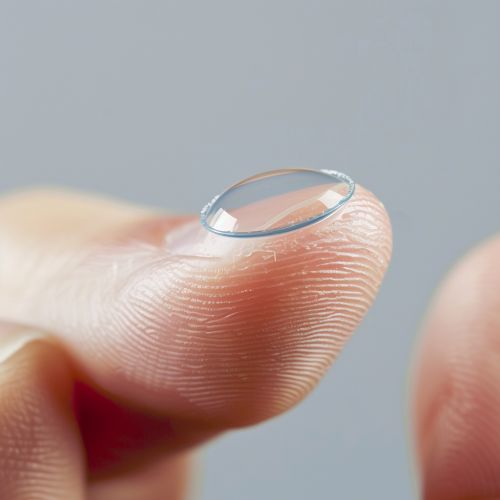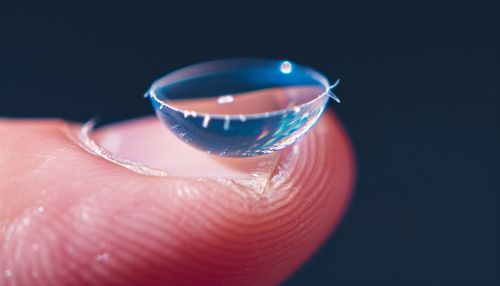Contact lens: Difference between revisions
(Created page with "== Introduction == <div class='only_on_desktop image-preview'><div class='image-preview-loader'></div></div><div class='only_on_mobile image-preview'><div class='image-preview-loader'></div></div> A contact lens, often referred to simply as a contact, is a thin, curved lens placed on the film of tears that covers the surface of the cornea. Contact lenses are medical devices used primarily for vision correction or for cosmetic or therapeutic reasons. They are typica...") |
No edit summary |
||
| Line 1: | Line 1: | ||
== Introduction == | == Introduction == | ||
[[Image:Detail-91235.jpg|thumb|center|A close-up image of a contact lens resting on a fingertip.|class=only_on_mobile]] | |||
[[Image:Detail-91236.jpg|thumb|center|A close-up image of a contact lens resting on a fingertip.|class=only_on_desktop]] | |||
A contact lens, often referred to simply as a contact, is a thin, curved lens placed on the film of tears that covers the surface of the [[cornea]]. Contact lenses are medical devices used primarily for vision correction or for cosmetic or therapeutic reasons. They are typically prescribed by an [[optometrist]] or [[ophthalmologist]] and can be used to correct a variety of [[refractive errors]], including [[myopia]], [[hyperopia]], [[astigmatism]], and [[presbyopia]]. | A contact lens, often referred to simply as a contact, is a thin, curved lens placed on the film of tears that covers the surface of the [[cornea]]. Contact lenses are medical devices used primarily for vision correction or for cosmetic or therapeutic reasons. They are typically prescribed by an [[optometrist]] or [[ophthalmologist]] and can be used to correct a variety of [[refractive errors]], including [[myopia]], [[hyperopia]], [[astigmatism]], and [[presbyopia]]. | ||
Latest revision as of 05:21, 22 June 2024
Introduction


A contact lens, often referred to simply as a contact, is a thin, curved lens placed on the film of tears that covers the surface of the cornea. Contact lenses are medical devices used primarily for vision correction or for cosmetic or therapeutic reasons. They are typically prescribed by an optometrist or ophthalmologist and can be used to correct a variety of refractive errors, including myopia, hyperopia, astigmatism, and presbyopia.
History
The concept of contact lenses dates back to the 16th century when Leonardo da Vinci sketched ideas for altering the optics of the human eye. However, it wasn't until the late 19th century that practical contact lenses were developed. In 1887, German glassblower F.A. Muller created the first known glass contact lens. By the 1930s, plastic lenses were introduced, which were lighter and more comfortable than their glass predecessors. The development of soft contact lenses in the 1970s, made from hydrogel materials, revolutionized the industry by providing greater comfort and extended wear times.
Types of Contact Lenses
Soft Contact Lenses
Soft contact lenses are made from hydrophilic (water-loving) materials that absorb water and become soft and flexible. They are the most commonly prescribed type of contact lens due to their comfort and ease of adaptation. Soft lenses are available in various forms, including daily disposables, bi-weekly, and monthly disposables. They can also be used to correct a range of vision problems, including astigmatism and presbyopia.
Rigid Gas Permeable (RGP) Lenses
Rigid Gas Permeable lenses are made from durable plastic that transmits oxygen to the eye. They are less flexible than soft lenses but offer superior vision correction, particularly for individuals with high astigmatism or keratoconus. RGP lenses are also known for their longevity and cost-effectiveness over time.
Hybrid Lenses
Hybrid lenses combine the features of both soft and RGP lenses. They have a rigid center that provides clear vision and a soft outer ring that enhances comfort. These lenses are particularly beneficial for individuals with irregular corneas or those who find RGP lenses uncomfortable.
Scleral Lenses
Scleral lenses are large-diameter RGP lenses that vault over the entire corneal surface and rest on the sclera (the white part of the eye). They are used to treat severe dry eye, keratoconus, and other corneal irregularities. Scleral lenses provide excellent comfort and stability, making them suitable for extended wear.
Materials and Manufacturing
Contact lenses are made from a variety of materials, each with specific properties that affect their performance and comfort. The primary materials used in contact lens manufacturing include:
Hydrogel
Hydrogel lenses are made from water-containing polymers that allow oxygen to pass through to the cornea. They are known for their comfort and ease of use, making them a popular choice for daily wear.
Silicone Hydrogel
Silicone hydrogel lenses are an advanced type of soft lens that allows even more oxygen to reach the cornea. This increased oxygen permeability makes them suitable for extended wear, including overnight use.
Fluorosilicone Acrylate
Fluorosilicone acrylate is a material used in RGP lenses. It combines the oxygen permeability of silicone with the durability of acrylate, providing clear vision and long-lasting performance.
Manufacturing Processes
Contact lenses are manufactured using various processes, including lathe cutting, spin casting, and cast molding. Lathe cutting involves shaping the lens from a solid block of material, while spin casting uses centrifugal force to form the lens shape. Cast molding is a highly efficient process that involves injecting liquid polymer into molds to create lenses.
Fitting and Prescription
Proper fitting and prescription of contact lenses are crucial for ensuring comfort, vision correction, and eye health. The fitting process typically involves:
Eye Examination
An eye examination by an optometrist or ophthalmologist is the first step in obtaining contact lenses. The examination includes a comprehensive assessment of vision and eye health, including measurements of corneal curvature and pupil size.
Trial Lenses
Trial lenses are often used to determine the best fit and prescription. The patient wears the trial lenses for a specified period, and adjustments are made based on comfort and vision performance.
Final Prescription
Once the optimal fit and prescription are determined, the final lenses are ordered. The prescription includes details such as lens power, base curve, diameter, and material.
Care and Maintenance
Proper care and maintenance of contact lenses are essential to prevent eye infections and ensure the longevity of the lenses. Key aspects of lens care include:
Cleaning and Disinfecting
Contact lenses should be cleaned and disinfected regularly using appropriate solutions. Multipurpose solutions are commonly used for cleaning, rinsing, and storing lenses. Hydrogen peroxide-based systems provide thorough disinfection but require neutralization before lens insertion.
Storage
Lenses should be stored in a clean lens case with fresh solution. The lens case should be replaced regularly to prevent contamination.
Handling
Proper handling techniques, such as washing hands before touching lenses and avoiding contact with water, are important to maintain lens hygiene and prevent infections.
Complications and Risks
While contact lenses are generally safe, improper use or poor hygiene can lead to complications, including:
Dry Eye
Dry eye is a common issue for contact lens wearers, characterized by insufficient tear production or poor tear quality. Symptoms include discomfort, redness, and blurred vision.
Infections
Microbial keratitis is a serious eye infection that can result from poor lens hygiene. Symptoms include pain, redness, discharge, and vision loss. Prompt medical attention is required to prevent complications.
Allergic Reactions
Some individuals may experience allergic reactions to lens materials or cleaning solutions. Symptoms include itching, redness, and swelling.
Corneal Abrasions
Corneal abrasions can occur due to improper lens handling or wearing damaged lenses. Symptoms include pain, tearing, and sensitivity to light.
Advances in Contact Lens Technology
Recent advances in contact lens technology have led to the development of innovative lenses with enhanced features:
Multifocal Lenses
Multifocal lenses are designed to correct presbyopia, allowing clear vision at multiple distances. They incorporate different lens powers within a single lens, providing a seamless transition between near, intermediate, and distance vision.
Toric Lenses
Toric lenses are specially designed to correct astigmatism. They have different powers in different meridians of the lens, providing precise vision correction for individuals with irregular corneal curvature.
Orthokeratology (Ortho-K)
Orthokeratology involves the use of specially designed RGP lenses worn overnight to temporarily reshape the cornea. This non-surgical method provides clear vision during the day without the need for glasses or contact lenses.
Smart Contact Lenses
Smart contact lenses are an emerging technology that incorporates electronic components into the lens. These lenses have the potential to monitor health conditions, deliver medications, and provide augmented reality experiences.
Regulatory and Safety Considerations
Contact lenses are regulated medical devices, and their safety and efficacy are overseen by regulatory bodies such as the U.S. Food and Drug Administration (FDA) and the European Medicines Agency (EMA). Key regulatory and safety considerations include:
Approval Process
Contact lenses must undergo rigorous testing and clinical trials to demonstrate their safety and effectiveness before receiving regulatory approval. This process includes assessments of material biocompatibility, oxygen permeability, and lens performance.
Adverse Event Reporting
Manufacturers are required to report adverse events associated with contact lens use to regulatory authorities. This helps monitor the safety of lenses and identify potential risks.
Consumer Education
Regulatory bodies emphasize the importance of consumer education on proper lens use, care, and hygiene. Educational materials and guidelines are provided to help users minimize risks and maintain eye health.
Future Directions
The field of contact lenses continues to evolve, with ongoing research and development aimed at improving lens performance, comfort, and functionality. Future directions include:
Enhanced Comfort
Researchers are exploring new materials and designs to enhance lens comfort, particularly for individuals with dry eye or sensitive eyes.
Drug-Delivering Lenses
Drug-delivering contact lenses are being developed to provide targeted treatment for eye conditions such as glaucoma and dry eye. These lenses release medications directly to the eye, improving treatment efficacy and patient compliance.
Vision Enhancement
Advancements in optics and electronics are paving the way for contact lenses that enhance vision beyond traditional correction. This includes lenses with adjustable focus, night vision capabilities, and augmented reality displays.
Conclusion
Contact lenses have transformed the field of vision correction, offering a convenient and effective alternative to glasses. With ongoing advancements in materials, design, and technology, contact lenses continue to improve in terms of comfort, safety, and functionality. Proper fitting, care, and adherence to guidelines are essential to ensure the best outcomes for contact lens wearers.
